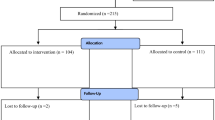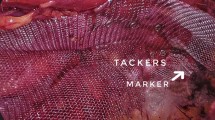Abstract
Background
This prospective, clinical, randomized, controlled study was performed to define the incidence of chronic pain after total extraperitoneal (TEP) repair with a light-weighted mesh compared with heavyweight mesh in patients with bilateral inguinal hernias.
Methods
Consecutive patients with bilateral inguinal hernias were recruited for TEP inguinal hernia repair under general anesthesia. Heavyweight mesh was randomly assigned to one side of the groin and lightweight mesh to the other. Patients were followed up regularly for up to 1 year by an independent surgeon who was unaware of the mesh assignment. The postoperative pain score by means of a visual analogue scale (VAS) and other data were recorded.
Results
Fifty bilateral TEP hernia repairs were performed between September 2007 and February 2009. Six patients (12%) complained of chronic pain 3 months after the operation. A higher average pain score was observed for the side of hernia repaired by heavyweight mesh compared with lightweight mesh, but the difference was not statistically significant. More patients complained about foreign body sensation on the side repaired with heavyweight mesh (24%) compared with the side with lightweight mesh (8%; P < 0.05). There was no recurrence or need for reintervention for either type of mesh.
Conclusions
Lightweight polypropylene mesh may be preferable to heavyweight mesh for TEP inguinal hernia repair because it provides less postoperative foreign body sensation; however, there was no significant difference in the incidence of chronic pain.
Similar content being viewed by others
References
The EU Hernia Trialists Collaboration (2001) Meta-analysis of randomized controlled trials. Ann Surg 235:322–332
Wright D, Paterson C, Scott N, Hair A, O’Dwyer PJ (2001) Five-year follow-up of patients undergoing laparoscopic or open groin hernia repair: a randomized controlled trial. Ann Surg 235:333–337
Kuhry E, van Veen RN, Langeveld HR, Steyerbery EW, Jeekel J, Bonjer HJ (2007) Open or endoscopic total extraperitoneal inguinal hernia repair? A systemic review. Surg Endosc 21:161–166
Poobalan AS, Bruce J, Cairns W, Smith S, King PM, Krukowski ZH, Chambers WA (2003) A review of chronic pain after inguinal herniorrhaphy. Clin J Pain 19:48–54
Memon MA, Cooper NJ, Memon B, Abrams KR (2003) Meta-analysis of randomized clinical trials comparing open and laparoscopic inguinal hernia repair. Br J Surg 90:1478–1492
Nienhuijs S, Staal E, Strobbe L, Roseman C, Groenewoud H, Bleichrodt R (2007) Chronic pain after mesh repair of inguinal hernia: a systemic review. Am J Surg 194:394–400
Weyhe D, Belyaev O, Muller C, Meurer K, Bauer KH, Papapostolou G, Uhl W (2007) Improving outcomes in hernia repair by the use of light meshes: a comparison of different implant constructions based on a critical appraisal of the literature. World J Surg 31:234–244
Cobb WS, Kercher KW, Heniford BT (2005) The argument for lightweight polypropylene mesh in hernia repair. Surg Innov 12:63
Ng WT, Chui LB (2008) Routine contralateral exploration is advisable during extraperitoneal hernioplasty for left inguinal hernia. Surg Endosc 22(3):806–807
Ng WT (2008) A cost-effective mesh design for extraperitoneal inguinal hernia repair using lightweight mesh. Hernia 12:447–448
Merskey H, Bogduk N (eds) (1994) Classification of chronic pain: descriptions of chronic pain syndromes and definition of pain terms. Task Force on Taxonomy of the I+ASP, 2nd edn. IASP Press, Seattle, WA, pp 209–214
O’Dwyer PJ, Kingsnorth AN, Molloy RG, Small PK, Lammers B, Horeyseck G (2005) Randomized clinical trial assessing impact of a lightweight or heavyweight mesh on chronic pain after inguinal hernia repair. Br J Surg 92:166–170
Post S, Weiss B, Willer M, Neufang T, Lorenz D (2004) Randomized clinical trial of lightweight composite mesh for Lichtenstein inguinal hernia repair. Br J Surg 91:44–48
Kehlet H, Jensen TS, Woolf CJ (2006) Persistent postsurgical pain: risk factors and prevention. Lancet 367:1625–1628
Felix E, Scott S, Crafton B, Geis P, Duncan T, Swell R, McKernan B (1998) Causes of recurrence after laparoscopic hernioplasty. Surg Endosc 12:226–231
Agrwal BB, Agarwal KA, Mahajan KC (2009) Prospective double-blind randomized controlled study comparing heavy-and lightweight polypropylene mesh in totally extraperitoneal repair of inguinal hernia: early result. Surg Endosc 23:242–247
Disclosures
Drs. Chui, Ng, Sze, Yuen, Wong, and Kong have no conflicts of interest or financial ties to disclose.
Author information
Authors and Affiliations
Corresponding author
Rights and permissions
About this article
Cite this article
Chui, L.B., Ng, W.T., Sze, Y.S. et al. Prospective, randomized, controlled trial comparing lightweight versus heavyweight mesh in chronic pain incidence after TEP repair of bilateral inguinal hernia. Surg Endosc 24, 2735–2738 (2010). https://doi.org/10.1007/s00464-010-1036-8
Received:
Accepted:
Published:
Issue Date:
DOI: https://doi.org/10.1007/s00464-010-1036-8




